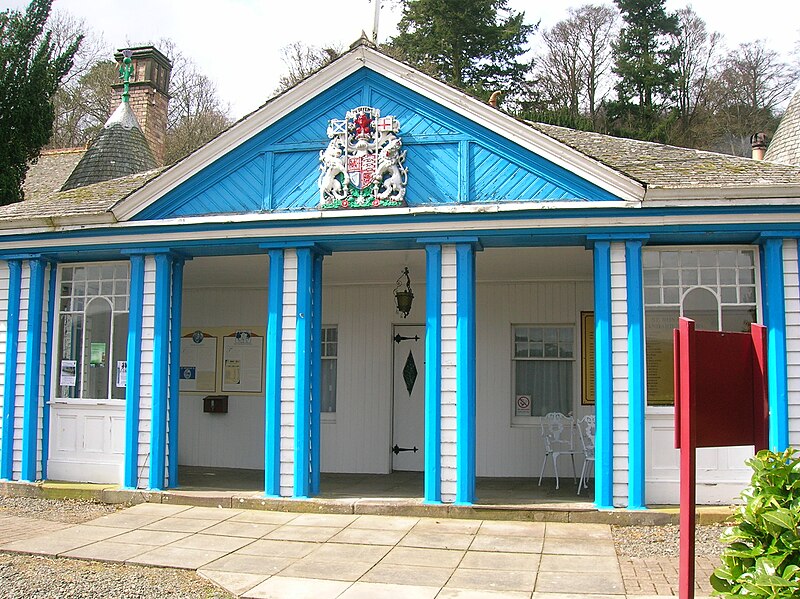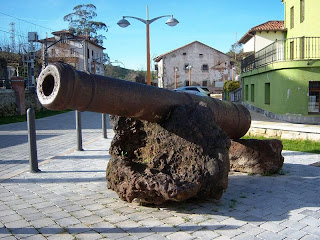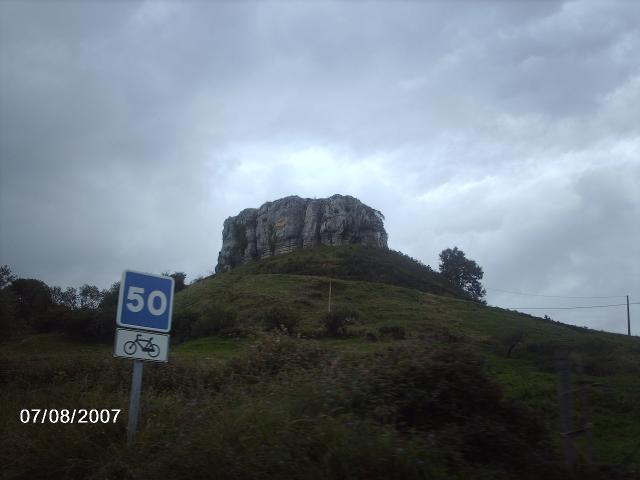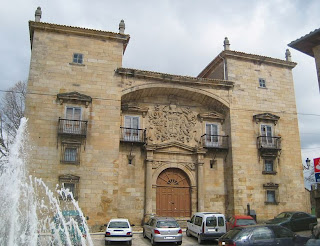 |
| Bridge over the Tweed, Peebles (CC3.0) |
 |
| Monument to the men of Peebles who gave their lives in the First World War |
Stage 1 of the 2011 Tour begins on the High Street in Peebles, Scotland, at approximately 10:15 on the 11th of September. Like many towns in Scotland, Peebles is in touch with its ancient past - the name is thought to derive from the word pebyll, meaning tents and presumably denoting a temporary settlement used by nomadic people, in the Brythonic language (which still exists in the form of Welsh/y Gymraeg, Breton/Brezhoneg and the revived Cornish language Kernowek) that is believed spoken by the Pictish people living here log before arrival of the Gaels, chiefly from Ireland, who would amalgamate with the Picts and thus give rise to the Scottish and the development of the Scots Gaelic language. These pre-Christian roots are plainly seen in the town's annual Beltane celebrations, a festival which in Celtic times involved assorted rituals intended to ensure the fertility of both the populace and the land and to repel harmful spirits. The practice of lighting Beltane fires appears to have survived without interval only in one or two parts of Ireland, but with the rise of neo-paganism and modern interest in Celtic mythology, Beltane festivities now take place in many parts of Ireland, Scotland, Wales and other Celtic nations. In Peebles, these celebrations involved the appointment of a Beltane Queen, these days a girl chosen from one of the town's primary schools, who is crowned among her courtiers on the steps of the parish church - since old churches were frequently erected on the site of much older, pre-Christian places of worship, there's a reasonable possibility that the ceremony has been taking place in the same location for much longer than the church has stood.
 |
| The Old Parish Church, Peebles |
Peebles became a Royal Burgh in 1152, during the reign of David I, thus giving it the right to representation in the Scottish parliament and to trade autonomously. This led to the establishment of a profitable market, attracting traders from a wide area and ensuring the town's relative wealth. From the Industrial Revolution right up until the latter half of the 20th Century, the woolen industry became hugely important to the town's economy and it was home to several mills, of which one still survives. From the middle of the 19th Century it also became a centre of health tourism based on the spa treatments made possible by the mineral water springs in the area. One spa survives, but most of the others have since been converted into hotels accommodating the many tourists who visit Peebles each year.
The wide, handsome High Street is lined with imposing buildings dating from various centuries, many of them occupied by shops selling shoes - the town has the highest number of shoe shops per capita in the United Kingdom - where the peloton will set out towards the Old Parish Church which, with construction beginning in 1885, is not quite as old as the name and Gothic styling suggests - the tower of St. Andrew's, standing alone in a graveyard since the church attached to it was ruined and its masonry recycled for use elsewhere, is far older. Arriving at a T-junction with a mini-roundabout around 130m after setting off, they turn right onto the A-72 and follow the road into Old Town and then the third turn on the right for Young Street, becoming Rossetta Street before another right turn onto March Street. Match Street narrows slightly towards the end, but not enough to cause problems unless anyone's still asleep and rides into the kerb which can be seen jutting into the road. A tight right turn at the end leads along the A703 Edinburgh Road which runs straight for 0.55km to a junction with the A72 Innerleithen Road.
 |
| Innerleithen: St. Ronan's Wells |
Having ridden 4.6km, the peloton arrive at the end of the neutral zone by a left turning onto a road leading to Glentress - home of a mountain biking centre with trails including the famous Spooky Woods and Ewok's Village (a North Shore-style freeride trail with elevated tracks, see-saws and so on), considered some of the best trails in the world. The route passes by, into a sweeping right/left bend leading into a 1.72km straight section ending in a slightly technical right bend with an easy entrance, straight ascending middle section and kinked exit - however. the short climb at the end of the preceding straight should reduce speeds sufficiently to prevent problems. Another straight section follows along the banks of the river, ending at a wide left bend leading into a 2.1km straight and another wide left around a hill topped by the remains of an Iron Age fort and heads into Innerleithen, 6.2km from the start. Almost immediately after entering the town, the route turns a very sharp right onto the B709 and reaches the first of three intermediate sprint at 7.2km, beginning by the cemetery gates.
Innerleithen is home to St. Ronan's Border Games, established in the middle of the 19th Century and today the oldest organised sporting event in Scotland and world class mountain bike trails, including a downhill course said to be especially challenging by those who do that sort of thing, forming part of the famous "7 Stanes" trails along with Glentress. The road narrows considerably as it passes across a bridge over the River Tweed, leading to potential problems if high speeds from the sprint create a bottleneck with several riders attempting to squeeze through together - the road remains narrow on the other side.
 |
| Traquair House, oldest continually inhabited house in Scotland. |
A tight right-hand bend lies 329m from the bridge, surrounded by trees and thus likely to be slippery if recent wind and rain have blown leaves onto the road (and since this is Scotland, they probably have done), before a 1km section starting with trees on the right of the road concealing Traquair House, believed to date from the 12th Cetury (though no surviving part can be dated before the 15th) and as such claimed to the oldest continually inhabited house in Scotland. Frequently used as an example of Scottish Baronial architecture, the House in fact predates the style and was a probable inspiration for it. The famous Bear Gates were closed in 1745 and have remained shut ever since, only to be reopened when a Stuart once again sits on the Scottish throne.
The B7062 becomes the B709 on the other side of a crossroads in the village, a road the race follows for the next 11.4km. The peloton climb as pass through Kirkhouse, reaching 200m just to the south between two farms. There's an easy left followed by a tight right 1.19km from the second farm before the road reaches 300m alongside a conifer plantation, climbing to approximately 360m before beginning to descend as we leave the plantation behind and travels across open moorland, passing by two ring-shaped enclosures 0.96km apart - it's impossible to say what they are from aerial photographs but they look to be of some antiquity. There are also two cattle grids - extremely hazardous unless hit at an angle very close to 90 degrees to the poles - located at 16 and 18.7km. After 20.5km, the route reaches a crossroads south-west of Montbenger and turns right at the Gordon Arms Hotel onto the A708 (there's an antique petrol pump set up in the carpark next to the hotel, if that sort of thing interests you). The road is straight and level all the way to St. Mary's Lake, following along the northern shore and arriving at Cappercleuch after 27.2km and a right turn onto a narrow unclassified road 160m after the orange "rumble strip" traffic-calming device immediately west of the village. It's an innocuous-looking road, but not without danger - 35-year-old David Stanners of Peebles CC was killed here after misjudging a bend and crashing into a wall on the 3rd of September 2011, just eight days before the Tour passes through. There are a further three cattle grids located at 30.2km, 35.9km and 38km, with the first climb of the race - Cat 3 Megget Hill - beginning at the third shortly after passing through Meggethead. The summit lies 0.4km after the start of the climb. There's a very steep descent - hazardous at 20% - 1km after the summit, the high speeds generated by it making a sharp right-hand bend 0.8km later hazardous.
 |
| Tweedsmuir Parish Church (CC2.0) |
The route turns north towards Talla Reservoir, the construction of which swelled the local churchyard for over 30 men - mostly Irish cheap imported labour - were killed whilst it was being built. Having passed along the edge of the water for around 1.63km, the road narrows slightly as it crosses a bridge. 2km later, the peloton turn a tight 90 degree left (by trees, hence possibly slippery) to pass along the dam, hitting an equally sharp right-hander 0.3km later. This road leads us to Tweedsmuir and a T-junction with A701, where the race turns left to head south-west. A short way away on the same road is the Crook Inn, made famous as the place where Rabbie Burns penned his poem Willie Wastle's Wife - not his best and somewhat questionable to modern tastes as it basically concludes Mrs. Wastle to be worthless as a human being due to her physical unattractiveness - and one of the many claimants to Oldest Pub in Scotland (there are many oldest pubs in Great Britain's constituent nations - I have personally been to four Oldest Pubs in England). 3.1km later, the race reaches the first drinks station - always a potential hazard as riders slow and grab the bidons (drinks bottles) held out to them by team employees. The next Cat 3 climb begins at 55km.
 |
| The Devil's Beef Tub (CC2.0) |
The summit comes 4.5km later near the Devil's Beef Tub, a 150m deep hollow between four hills described by Sir Walter Scott as "a damned deep, black, blackguard-looking abyss of a hole" (it's actually quite attractive). The name comes from the hollow's use by the Johnstone clan, described by the farmers in the area upon whom they preyed as devils, as a place to hide stolen cattle. The descent into Moffat, 70.1km from the start of the race, is undemanding in the dry; though as ever on a descent unpredictable factors such as punctures can rapidly become disastrous.
Moffat has been a tourist destination ever since the 17th Century when health benefits were first ascribed to the sulphurous waters that bubble up in the area - during the height of the spa's popularity, a special pipeline was built to carry the water from a well on the hills down to a bath house in the town and several hotels sprang up - one, The Star, was listed in the Guinness Book of Records as the narrowest hotel in the world at just 6m wide. The stage's second intermediate sprint begins at Moffat's town hall, housed in the old bath house on the A701 running west of the High Street. Reaching a short road connecting the two, the peloton turns a tight 90 degree left and right - this being in the middle of the town, there's the potential for diesel and puncture hazards on the road - heading out of town along the High Street and, having negotiated the tight left bend at the end, on the A708. After half a kilometre, the race turns right onto the Old Carlisle Road. Following the undemanding road until 80.1km leads to a junction and a sharp right into Newton. They pass over two bridges, one crossing a river and one a motorway, then turn left onto the B7076. The 1km long feed zone - another hazard as riders slow down and grab musettes (cloth bags filled with energy gel and the various things professional cyclists have to eat), domestiques loading up and ferrying the bags back to their teams.
The route remains level and straight until it reaches Johnstonebridge where the peloton turn a sharp right into the village which marks the approximate halfway point of the stage. At the next junction, they turn left and past a farm, riding through a small wood as the road climbs slightly before a short descent towards a difficult left-hand bend in woodland, caution being required in case of slippery leaves on the road and possibility of punctures. There's a very short but steep climb in the woods before the road begins to descend on the way out towards the crossroads, which the race travels straight across to arrive at a T-junction 0.39km later. They turn right here, heading towards St. Ann's, then a wide left bend takes the race through 180 degrees onto the A701 continuing through Parkgate at 98.5km, Amisfield, Locharbriggs and into Dumfries.
 |
| The Old Bridge, known to locals as Auld Brig, Dumfries (CC3.0) |
Dumfries, the largest town we've yet seen on this stage. Like Peebles a Royal Burgh until the distinction was abolished, Dumfries was the site where in 1264 King Alexander III met with his knights to plan an invasion of the Isle of Man, once under Scottish rule but controlled by the Norwegian monarchy for almost two centuries. William Wallace and his rebels passed through in the latter years of the same century, chasing an English army who applied for protection at the now vanished Dumfries Castle but were refused, eventually being caught and slaughtered at Cockpool some kilometres to the south on the Solway Firth coast. The town has a long and bloody history - not only was it the scene of several vicious attacks and lootings at the hands of the English, it also executed ten "witches," the unfortunate women being tied to stakes and strangled before their bodies were burned. As late as 1868, it was the site of the last public hanging to take place in Scotland. Strangely, it has experienced two earthquakes on Boxing Day - one in 1979 and another in 2006. Its police force is the smallest in Scotland, but played a large role in one of the largest criminal investigations ever to take place - that following the bombing of Pan-Am 103 which fell on the nearby town of Lockerbie.
Remaining on the A701 through the town, the race takes the second exit of the first roundabout onto Edinburgh Road, doing the same at two more roundabouts until the road becomes Academy Street before negotiating Church Crescent and turning left before the bridge onto White Sands which, later on, will host the finish line of the stage. As the peloton crosses it. 0.5km from the corner, they begin the third intermediate sprint. Reaching the end of the road, the riders turn a sharp right onto St.Michael's Bridge leading to St. Micheal's Bridge Road becoming Pleasance Avenue. This leads them to a T-junction with the A710 where they turn left to head south towards the Solway Firth. 2.24km ahead, they reach a tight 90 degree right corner followed by an equally tight 90 degree left 0.38km later on the way through Islesteps. Another tight left lies 2.63km away; followed by a medium left bend left, tight 90 degree right and hump-backed bridge at New Abbey, with a medium left on the way out for good measure. New Abbey is the site of the not-very-new, ruined and delightfully named Sweetheart Abbey, founded in 1273 by Dervorguilla of Galloway in memory of her husband John Balliol, himself the founder of Balliol College at Oxford University.
 |
| The Solway Firth served as a backdrop to the fictional Summerisle in the 1973 film The Wicker Man (CC2.0) |
The road climbs and then descends gently over the next 7.8km to Kirkbean, the route consisting of long straights with no challenging bends. The village was the birthplace in 1747 of John Paul Jones who went on to found the United States Navy. In days gone by, thousands of people seeking a better life in America passed through here before setting sail on the ships that sailed from the inlet formed by the River Nith's estuary on the Solway Firth just to the east, but today it's a quiet place given over to nature. A nature reserve on the far bank is an important breeding place for several species of birds. The race continues through on the same road, reaching Caulkerbush and a slight left before taking a tight right 54m later onto the B793. The Cat 3 climb of Banks Hill begins 0.95km after the turning as the peloton pass a large house to the right of the road, just past a junction. It ends 1.5km later along the straight road, in between farm gates on the left and right,, almost precisely 140km from the start of the race.
 |
| Beeswing Kirk - a church converted into a private home (CC2.0) |
A medium left some distance ahead sees the road begin to descend again before arriving at a T-junction, turning an easy right before continuing to Edingham, site of an industrial complex and hence another potential spot for diesel spills. There are some large circular earthworks just right of the road as it passes the turn for the complex before arriving at a T-junction with the A711 where the peloton turn right. The road remains wide and unchallenging for 9km with exception of a slight climb towards the village of Beeswing.
Anywhere with a name such as Beeswing very obviously deserves a closer look - and an explanation of the strange name. Originally named Lochend, the village elected to rename itself after a famous thoroughbred mare, winner of 51 races during her short eleven-year life. The horse was neither from here nor ever visited, an indication of the high esteem in which she was held. There's a very steep descent 1.56km past Lochanhead, the road dropping more than 60m in around 0.7km, followed by a slight rise into Cargenbridge before the race reaches Dumfries 1.2km later. Having passes straight across two roundabouts and along Cassalands and Galloway Street, the peloton arrives at a bridge, crossing the river and turning a sharp left to enter White Sands. Following a final 300m sprint, the stage ends after traveling 170.3km from the start line.
Predictions: Now, we could be wrong because he'd plainly have far rather been at the Vuelta a Espana, but we can't see any reason why Thor Hushovd won't win this one easily. However, strange things happen in these smaller Tours - while the bog boys are all tuned to the three week Grand Tours, the lesser-known lads will go hell for leather caring not in the slightest if the quest for glory leads to an early burn-out.
Weather: Wet - and very wet. Rain is expected across many parts of Britain tomorrow, with the heaviest of all predicted for Western Scotland. That ought to be a fun start. Wind is a little tricky to predict at the moment due to Hurricane Katia lurking off Newfoundland over on the opposite side of the Atlantic - very strong wind is expected for the area in the next few days, but at present it looks as though it won't get too rough until Sunday night or Monday. The maximum temperature might climb to 18C, but probably not: 14 or 15C is more likely.


































